| Reviews & Columns |
|
Reviews DVD TV on DVD Blu-ray 4K UHD International DVDs In Theaters Reviews by Studio Video Games Features Collector Series DVDs Easter Egg Database Interviews DVD Talk Radio Feature Articles Columns Anime Talk DVD Savant Horror DVDs The M.O.D. Squad Art House HD Talk Silent DVD
|
DVD Talk Forum |
|
|
| Resources |
|
DVD Price Search Customer Service #'s RCE Info Links |
|
Columns
|
|
|
Man From U.N.C.L.E.: The Complete Series, The
"Open Channel D."
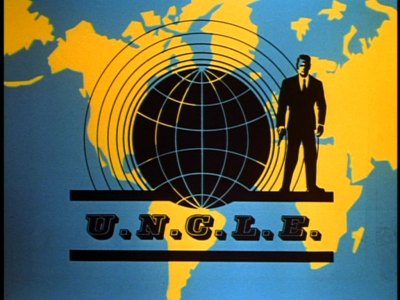
The release by Time-Life of the mammoth, 41-disc DVD collection of The Man From U.N.C.L.E.: The Complete Series was a complete revelation to me. Not only does the box set contain all 105 episodes of this smashing sixties spy series, but a copious amount of extras are included that will blow away even the most serious U.N.C.L.E. fan. And for a novice to the series like myself, the ability to see this witty, exciting show from absolute beginning to end, was a major event.
To be honest, I'm not sure I ever saw a complete episode of The Man From U.N.C.L.E. prior to this box set. I was certainly aware of the series when I was a kid (one of my older brothers had all the toy gear, including one of the complete U.N.C.L.E. guns!), but at least in my region of the country, the harder-to-sell one-hour series wasn't syndicated year after year, achieving the kind of audience saturation half-hour comedies like Gilligan's Island and Hogan's Heroes regularly attained. I know it was briefly brought back by TNT, I believe, in the 1980s, and I may have tuned in once or twice, but the constant commercials and the less-than-stellar prints turned me off. I never even caught one of the several episode compilations that series' producers cut into feature length films, that show regularly on TCM.
So I had absolutely no preconceived notions about The Man From U.N.C.L.E. when I faced the rather daunting challenge of going through all 41 discs in this colossal box set. After watching the first six or seven episodes, I was shocked at how good the series was - most particularly the first black & white season, which many die-hard fans would agree is the series' stand-out season. Having written a book on spy films, I was pretty familiar with most TV incarnations of the espionage genre, and for my money, the best was always The Avengers (with Secret Agent, I Spy, The Saint, and The Wild, Wild West all jockeying for second). So I was more than pleasantly surprised when most of the episodes of the first season of The Man From U.N.C.L.E. reached the level of sophistication, wit, flat-out action, and a dead-pan, slightly surreal atmosphere that so-often marked John Steed's and Miss Emma Peel's delightful adventures.
The Man From U.N.C.L.E. started as a collaboration between M-G-M-TV executive producer Norman Felton (TV's Dr. Kildare) and the creator of the modern spy novel, James Bond's Ian Fleming, who was looking to capitalize on the success of his novels (and the initial success of the Bond film adaptations) by branching out into television. Ideas were bandied about, but nothing concrete was hatched except for Fleming giving Felton a suitably Bondian name for his TV protagonist: Napoleon Solo (evidently, the Bond film producers made it known to Fleming that they weren't happy about his foray again into TV, so he backed off).
Enter writer/producer Sam Rolfe (co-creator of one of the most literate, striking TV westerns ever, Have Gun Will Travel), who, working with Felton, created the initial framework for the series: a multi-national spy agency, with no specific political agenda, drawing agents from every country who worked together to protect and maintain "world peace." Named "U.N.C.L.E.," the United Network Command for Law and Enforcement was secretly headquartered out of New York City, where one of the accesses to the futuristic offices was hidden away in a changing room in the basement Del Floria's Tailor Shop. Although originally conceived to feature just one agent, actor Robert Vaughn's Agent "Solo," Rolfe's plan to include minor characters of different nationalities (a novel idea at the time during the Cold War, and an obvious nod to the U.N., reflected as well in the first two initials of U.N.C.L.E.) eventually resulted in Russian agent Illya Kuryakin taking on team member status with Solo (facilitated by the popularity of David McCallum's portrayal of the mysterious Russian). Piloting the New York offices and personally directing the operations of the various teams was U.N.C.L.E. chief Alexander Waverly (Leo G. Carroll), who increasingly looked askance at the sometimes unconventional methods of his two most successful agents.
Naturally, U.N.C.L.E. needed a nefarious organization to battle, which was provided by Thrush, a shadowy world-wide criminal organization that gave aid and comfort to a bizarre amalgamation of steely-eyed opportunists, cold, deadly assassins, mundane bureaucrats, and half-crazed megalomaniacs - all of whom would stop at nothing to subvert world peace in order claim dominion over the civilized world. As Napoleon Solo aptly puts it, "Thrush believes in the two-party system: the masters and the slaves." Although often on first name basis with Thrush agents, and not above trading witty banters with the opposing force, Solo and Kuryakin don't hesitate to blast away at the villains at the drop of a hat, in deference to the organization's zeal in subverting world peace (the show, thankfully, is refreshingly violent when it comes to the killing; the tone may be light, but agents get shot dead). Again, Solo puts it best about Thrush's ruthlessness when he states, "Thrush kills people like people kill flies."
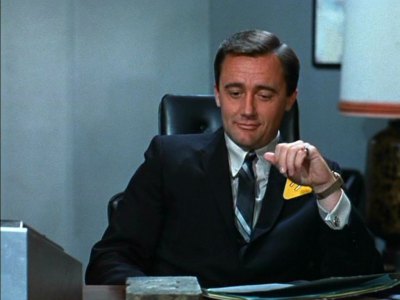
The first season of The Man From U.N.C.L.E. is most interested in examining the hidden, seething world of espionage and world threat that lurks behind the most mundane facades. A grubby service entrance to an anonymous skyscraper leads to an elevator, which leads to an unnamed thirteenth floor, where Thrush works in total anonymity. A cramped, basement-level tailor shop has a primitive, dark changing room that, with the push of a coat hook, reveals the fabulous offices of U.N.C.L.E.. And throughout the M-G-M backlot "New York," U.N.C.L.E. and Thrush agents pop in and out of unlikely holes, and false-fronts, and anonymous delivery vans and city taxis like jack-in-the-boxes, battling each other with impunity on the oblivious streets of Manhattan. And the perfect portal to this veiled world of mayhem is the series' most ingenious audience hook: "The Innocent."
In every episode of The Man From U.N.C.L.E., an "innocent," an ordinary person (often a housewife or minor functionary), is drawn into the adventures of Solo and Kuryakin, often playing a pivotal, certainly dangerous role in the covert operation. While spy films had often utilized such a plot device, The Man From U.N.C.L.E. makes it a central theme of its show, placing the audience surrogate squarely in the middle of the action - something certainly the Bond films and other TV spy series never did. The appeal of the Bond film character is essentially a Superman agent, who has an encyclopedic knowledge of wine, women, clothes, and combat, who can always save the day, and rarely, if ever, with the need of assistance from another person. The Man From U.N.C.L.E. subverts that, often making the case that the competent agents (who would, admittedly, become more cartoonishly competent, and thus more Bondian, as the series progressed) absolutely needed the aid of "the innocent" to pull off their various operations. This theme fit well with the producers' choices of actors to play the leads here. Vaughn and McCallum, certainly not as physically prepossessing as strapping Sean Connery, seem like more down to earth, believable spies, if you will (until the gradual outlandishness of the series defeated that feeling) whose physical capabilities, while never in question, certainly aren't infallible. They're just as much "thinking" spies as "shooting" spies, and as such, more open to utilizing someone else's talents to complete their mission. This, along with "the innocent" often being a woman who finds a certain kind of liberation and new-found freedom after working with the U.N.C.L.E. agents, were additional departures from the conventions of most mid-60's TV shows.
What stands out for me this first season - and from the rest of the series - is the witty, continental flair of the writing, and the sly, knowing direction for these spy soufflés. There's a droll urbanity to the first season The Man From U.N.C.L.E. scripts that's quite refreshing and light. Often striving for a Hitchcockian touch (violence and humor mixed with sexuality), the U.N.C.L.E. stories rely more on sharp, amusing dialogue, rather than constant fisticuffs, creating a denser-than-usual viewing experience. Having seen literally thousands of hours of TV and movie spy stories, I was delighted by the often quirky little additions the series managed during this first season. It's an attention to detail - often amusing, sideways details, for that matter - that puts U.N.C.L.E. on the same footing as the similarly toned The Avengers. When Solo has to run from a sniper's bullet, he doesn't quite run, but manages a sort of jaunty jog. In The Green Opal Affair, Solo humorously continues to fire his empty weapon at all the surrounding villains, before pointing the gun at us, breaking the fourth wall. In The Deadly Games Affair, Solo, after seeing a villain pop out of a hole, relays "You've got a lot of gopher in you," not with a sneer, but with genuine admiration. The standard Bondian put-downs after some assassin would take a bullet would come in later seasons, but for now, these agents derived as much pleasure from talking with their adversaries, as they did from drilling them full of holes.
There's a playfulness to the proceedings, no doubt aided greatly by perfectly cast Vaughn and McCallum, that's infectious right from the start. Vaughn, effortlessly charming and ever-so-slightly smug - but without even the slightest hint of being off-putting - has a perpetual sneer at his lips as he shrugs his way through one ridiculous Perils of Pauline predicament after another (I love his nonchalant smirk as he walks into Del Floria's Tailor Shop, which is featured in the opening title credits for the first season). He really is rather debonair, in the truest sense of the word - something that can't be said for any modern actor working today. I miss that certain American stereotype - the cultured, witty American - that has utterly vanished from the popular culture (perhaps forever), so it's a treat to see Vaughn enact so perfectly, one of the last shining moments of such a character.
McCallum, on the other hand, was something new to American TV audiences: a Russian hero (can you imagine such a character appearing ten years before on the Big Three?). Although never intended as an equal-billed lead, McCallum's Kuryakin became such a media sensation (as well as the object of thousands of young girls' fantasies), that he was quickly pushed to the forefront of the series. Projecting an aloof, enigmatic air of mystery, the hip Russian who liked jazz and sported turtlenecks with his blazers (a "beat" identifier if there ever was one) struck a chord with young audiences who were just beginning to look for something other than the standard 1950s American action hero. And although McCallum frequently makes Kuryakin's demeanor one of impassive rationality, he's smart enough to layer it with a bemused twinkle that shows through now and then, ingratiating himself with the audience. Together, Vaughn and McCallum present a united front of unflappable cool that must have been quite admirable to the men watching, as well as a solid one-two punch to the female viewers at home.
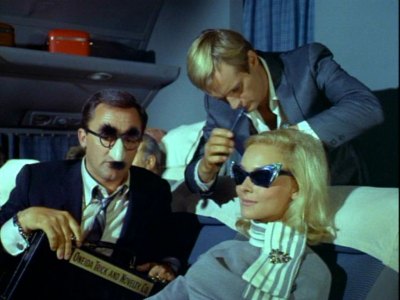
But as light and charming as The Man From U.N.C.L.E. is, it's also quite spirited in its action sequences, creating some rather startling, creepy moments during this first season. In the series' second episode, The Iowa-Scuba Affair, there's a terrific sequence where Thrush agents stalk Solo and his pretty cohort in the woods. Thrush, armed with "black light emissions" scopes on their rifles that create an unsettling chirping noise, surround the couple as they try to bring down Solo. It's a marvelous, almost "New Wave-y" moment, with beautiful black & white chiaroscuro lighting (featured in all of these good looking first season episodes), jump cuts and the sight of these masked, surreal assassins. I'm not sure it ever got any better than this moment in the entire series, but fortunately, the first season of episodes were filled with similarly innovative, striking moments such as that.
Of course, fans of the show mark the second season, with its move to color and its gradual, increasing emphasis on "comedy" over "wit," as the first inklings of the beginning decline of this three-and-a-half season series, with the third season becoming an out-and-out, ill-advised parody of its former self. Certainly the loss of series co-creator and producer Sam Rolfe gave the show a body blow from which it never fully recovered. Successive producers either didn't understand the series' appeal or, encouraged by the massive ratings from season two, tried to divine what was "working" with the public instead of sticking to Rolfe's original intention.
Other outside factors didn't help the new producers of The Man From U.N.C.L.E. stick to the original formula, either. The initial impetus for the creation of The Man From U.N.C.L.E. was to take James Bond, and put him on American television. And while the first season of episodes play very much like the first two Bond epics, Dr. No and particularly From Russia With Love, subsequent seasons play more and more like the outsized moments found in Goldfinger, Thunderball, and You Only Live Twice. And who can really blame the new producers for going with what the public obviously adored? In 1964 and 1965, "Bondmania" reached worldwide proportions, second only to "Beatlemania," creating the first such worldwide pop culture phenomenon associated with a film series. And as Francois Truffaut famously (as well as petulantly and ultimately incorrectly) remarked, when that ejector seat exploded in Bond's Goldfinger Aston Martin, the end of serious cinema began. Clearly, "bigger" was always "better" with Bond, and M-G-M, having a certifiable craze on their hands with the U.N.C.L.E. franchise, wanted to align the show as closely as possible with the most successful film series in film history.
As well, during the second season of The Man From U.N.C.L.E. (1965-1966), the two weekly installments of ABC's Batman were charting separately in the Nielsen Top Ten, week after week, creating their own dizzying fad of millions in merchandising profits and reams of publicity. Soon, The Man From U.N.C.L.E. would follow suit, selling its light, witty Hitchcockian soul for the campy excesses of Gotham's Bruce Wayne. There seems to be a natural tendency for viewers to look down on the broader forms of spoof and slapstick, particularly when they creep into a TV series that started out with an altogether different tone. Series that are on long enough tend to morph and change focus and atmosphere, and each permutation has its detractors and supporters. The switch from the velvety, expressive black & white of season one, to the flatter, more broadly lit, almost garish, cartoony color of the remaining seasons, alone helps alter the mood and feel of The Man From U.N.C.L.E., but I'm not willing to put down the later seasons just because they differ so strikingly from the first one.
Actually, the second season, for the most part, plays not unlike the first. There's still a good balance of solid espionage suspense, balanced by a light, satirical tone that's most appealing. The opener, Alexander the Great Affair, Parts I and II, is a good example of the spirit of season one carried over into this switch to color. Rip Torn is a suitably crazy U.N.C.L.E. opponent, and his torture chamber imprisonment of Solo and Kuryakin is nicely balanced between fanciful and adventuresome. The Foxes and Hounds Affair sports my favorite Thrush leader: Vincent Price as Victor Marton. Playing it restrained (for Price), he has the perfect stature for this kind of role, bringing all his past film associations along with him, giving the role some needed scale. The Deadly Toys Affair has a juicy turn by Angela Lansbury (always welcome in these types of roles), while The Moonglow Affair finds Mary Ann Mobley surprisingly accomplished and bright as U.N.C.L.E. trainee, April Dancer.
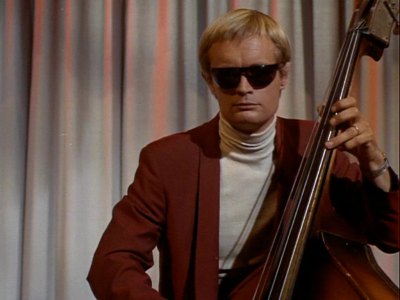
But ominous signs were on the horizon this second season. You might even say they occurred towards the end of season one, with The Never-Never Affair's brilliant, campy movie theater shoot-out between Thrush and Solo and Kuryakin, tipping the scales towards over-the-top comedy (I love the audience member yelling, "Down in front!" as the agents battle it out). Illya, quickly becoming the fan favorite of the series, is increasingly used as a comic prop (The Foreign Legion Affair and The Indian Affairs Affair), while the humor becomes more forced and outside the confines of characterization. As for season three, it's largely a misfire (if you directly compare it to season one), emphasizing Batman camp at the expense of the frothy, witty sense of style the early U.N.C.L.E. scripts possessed. With the possible exception of The Concrete Overcoat Affair, Parts 1 & 2, where Jack Palance is memorable as a mafia thug (tellingly, this was Sargent's and Field's last U.N.C.L.E. assignment), much of season three is fairly flat and disposable. I won't call it a disaster, as rapid fans of the series are quick to label it. It does have a certain overplayed energy, and "garish" doesn't always equal "bad." But going that far "out" really stretches the viewer's tolerance of the series' internal logic (watch The My Friend, the Gorilla Affair to see what I mean).
As for the final, aborted fourth season, a conscious return to the seriousness of the first season did little to alleviate the feeling that the audience (this viewer included) had seen all of this before. After the ridiculousness of the third season, season four comes over as rather dour and humorless - although there are better performances this season, including a great turn by Jack Lord in The Master's Touch Affair. And though they're pros right up until the end, it's not difficult to sense in both Vaughn's and McCallum's performances, that they knew the fad (and most of the fun) was over, too. Each season of The Man From U.N.C.L.E. has a distinctive feel (no doubt due to the several replacements of producers), and while fans obviously like to discuss the merits and drawbacks of each one (as attested to on several of the bonus features), even some of the more flat and humorless, or outrageous and outlandish episodes of The Man From U.N.C.L.E. still have quite a bit going for them. And when the series is flying high (almost the entire first season, and much of the second), nothing comparable can touch it.
Watching The Man From U.N.C.L.E., you'll notice the full resources of the M-G-M backlot at work here, as well as a glossier-than-normal production design courtesy of the once-premiere studio. And evidently, M-G-M-TV's involvement with the show proved fortuitous, considering the series was almost canceled right out of the gate. Premiering on September 22, 1964 in a death slot of Tuesday nights at 8:30pm (opposite the sixth most popular show on television, The Red Skelton Hour over on CBS, and Top Thirty contender, McHale's Navy on ABC), ratings were so poor that NBC seriously considered canceling the expensive project, cutting their losses before committing to a full season (and a full season back in 1964 was an amazing 29 hour long episodes, compared to today's paltry, 17 - 21 orders).
However, a time slot move mid-season proved to be the series' saving grace. Now battling older-skewing To Tell the Truth and I've Got a Secret on CBS, and the premiering Voyage to the Bottom of the Sea (which had the misfortune of being on ABC, which didn't have the ratings coverage of the other two networks), The Man From U.N.C.L.E. built rapidly in the ratings. And the old M-G-M publicity machinery, still viable after the golden years of the Hollywood studio system, aided that climb by relentlessly pushing the series in the printed media, TV, radio, and through a series of widely publicized visits by the stars of the show, who traveled all over the country, promoting The Man From U.N.C.L.E.. All the hard work paid off. Season two (1965-1966) found The Man From U.N.C.L.E. in a new time slot (Friday nights at 10:00pm), facing zero competition in Slattery's People and The Jimmy Dean Show. Ratings skyrocketed, with The Man From U.N.C.L.E. finishing 13th for the year in the Nielsen's. U.N.C.L.E. mania hit full bloom, with hundreds of merchandising tie-ins flooding stores all over the country, and re-cut episodes, released as feature films in movie theaters, raking in millions all over the world.
But as with all fads, the fall was just as steep as the climb. It didn't help that NBC created a spin-off, The Girl From U.N.C.L.E., that further watered down the original series, which had itself veered into full-blown, Batman camp by this third season. Another time shift change (back to 8:30pm on Fridays, against still potent Hogan's Heroes and The CBS Friday Night Movie) didn't help matters, either, with the audience having an increasingly difficult time staying loyal to the show and their own viewing patterns. The Man From U.N.C.L.E., the previous season's runaway success story and bona fide cultural phenomenon, was nowhere to be seen in the 1966-1967 Nielsen Top Thirty.
The fourth season's belated, "Hail Mary" return to seriousness didn't counter the audience's obvious disinterest in the series, with another time slot change, 8:00pm on Mondays, proving to be the series' death blow. Going up against the last half hour of the fourth most popular show on television, Gunsmoke, and the beginning of the second most popular series for the year, The Lucy Show, The Man From U.N.C.L.E. was blown out of the water. It didn't even survive the full season, with the plug yanked on January 15, 1968. What started out as an obscure, expensive experiment, quickly became a worldwide sensation, only to flame out three-and-a-half short years later.
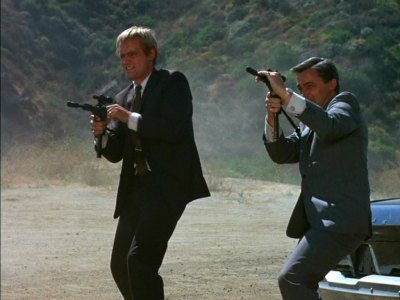
Here are the 29, one hour episodes of the ten-disc box set, The Man From U.N.C.L.E.: The Complete Season 1 (bonus discs will be discussed together under "The Extras" below):
DISC ONE:
The Vulcan Affair (September 22, 1964)
The Iowa-Scuba Affair (September 29, 1964)
The Quadripartite Affair (October 6, 1964)
DISC TWO:
The Shark Affair (October 13, 1964)
The Deadly Games Affair (October 20, 1964)
The Green Opal Affair (October 27, 1964)
DISC THREE:
The Giuoco Piano Affair (November 10, 1964)
The Double Affair (November 17, 1964)
The Project Strigas Affair (November 24, 1964)
DISC FOUR:
The Finny Foot Affair (December 1, 1964)
The Neptune Affair (December 8, 1964)
The Dove Affair (December 15, 1964)
DISC FIVE:
The King of Knaves Affair (December 22, 1964)
The Terbuf Affair (December 29, 1964)
The Deadly Decoy Affair (January 11, 1965)
DISC SIX:
The Fiddlesticks Affair (January 18, 1965)
The Yellow Scarf Affair (January 25, 1965)
The Mad, Mad Tea Party Affair (February 1, 1965)
DISC SEVEN:
The Secret Sceptre Affair (February 8, 1965)
The Bow-Wow Affair (February 15, 1965)
The Four-Steps Affair (February 22, 1965)
DISC EIGHT:
The See-Paris-And-Die Affair (March 1, 1965)
The Brain-Killer Affair (March 8, 1965)
The Hong Kong Shilling Affair (March 15, 1965)
DISC NINE:
The Never-Never Affair (March 22, 1965)
The Love Affair (March 29, 1965)
The Gazebo in the Maze Affair (April 5, 1965)
DISC TEN:
The Girls of Nazarone Affair (April 12, 1965)
The Odd Man Affair (April 19, 1965)
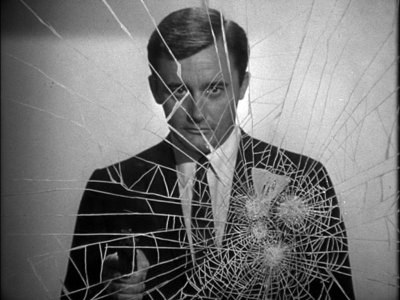
Here are the 30, one hour episodes of the ten-disc box set, The Man From U.N.C.L.E.: The Complete Season 2:
DISC ONE:
Alexander the Great Affair, Part I (September 17, 1965)
Alexander the Great Affair, Part II (September 24, 1965)
The Ultimate Computer Affair (October 1, 1965)
DISC TWO:
The Foxes and Hounds Affair (October 8, 1965)
The Discotheque Affair (October 15, 1965)
The Re-Collectors Affair (October 22, 1965)
DISC THREE:
The Arabian Affair (October 29, 1965)
The Tigers Are Coming Affair (November 5, 1965)
The Deadly Toys Affair (November 12, 1965)
DISC FOUR:
The Cherry Blossom Affair (November 19, 1965)
The Virtue Affair (December 5, 1965)
The Children's Day Affair (December 10, 1965)
DISC FIVE:
The Adriatic Express Affair (December 17, 1965)
The Yukon Affair (December 24, 1965)
The Very Important Zombie Affair (December 31, 1965)
DISC SIX:
The Dippy Blonde Affair (January 7, 1966)
The Deadly Goddess Affair (January 14, 1966)
The Birds and the Bees Affair (January 21, 1966)
DISC SEVEN:
The Waverly Ring Affair (January 28, 1966)
The Bridge of Lions Affair (Part I) (February 4, 1966)
The Bridge of Lions Affair (Part II) (February 11, 1966)
DISC EIGHT:
The Foreign Legion Affair (February 18, 1966)
The Moonglow Affair (February 25, 1966)
The Nowhere Affair (March 4, 1966)
DISC NINE:
The King of Diamonds Affair (March 11, 1966)
The Project Deephole Affair (March 18, 1966)
The Round Table Affair (March 25, 1966)
DISC TEN:
The Bat Cave Affair (April 1, 1966)
The Minus-X Affair (April 8, 1966)
The Indian Affairs Affair (April 15, 1966)
Here are the 30, one hour episodes of the ten-disc box set, The Man From U.N.C.L.E.: The Complete Season 3:
DISC ONE:
The Her Master's Voice Affair (September 16, 1966)
The Sort of Do-It-Yourself Dreadful Affair (September 23, 1966)
The Galatea Affair (September 30, 1966)
DISC TWO:
The Super-Colossal Affair (October 7, 1966)
The Monks of St. Thomas Affair (October 14, 1966)
The Pop Art Affair (October 21, 1966)
DISC THREE:
The Thor Affair (October 28, 1966)
The Candidate's Wife Affair (November 4, 1966)
The Come with Me to the Casbah Affair (November 11, 1966)
DISC FOUR:
The Off-Broadway Affair (November 18, 1966)
The Concrete Overcoat Affair, Part I (November 25, 1966)
The Concrete Overcoat Affair, Part II (December 2, 1966)
DISC FIVE:
The Abominable Snowman Affair (December 9, 1966)
The My Friend the Gorilla Affair (December 16, 1966)
The Jingle Bells Affair (December 23, 1966)
DISC SIX:
The Take Me to Your Leader Affair (December 30, 1966)
The Suburbia Affair (January 6, 1967)
The Deadly Smorgasbord Affair (January 13, 1967)
DISC SEVEN:
The Yo-Ho-Ho and a Bottle of Rum Affair (January 20, 1967)
The Napoleon's Tomb Affair (January 27, 1967
The It's All Greek to Me Affair (February 3, 1967)
DISC EIGHT:
The Hula Doll Affair (February 17, 1967)
The Pieces of Fate Affair (February 24, 1967)
The Matterhorn Affair (March 3, 1967)
DISC NINE:
The Hot Number Affair (March 10, 1967)
The When in Roma Affair (March 17, 1967)
The Apple a Day Affair (March 24, 1967)
DISC TEN:
The Five Daughters Affair, Part I (March 31, 1967)
The Five Daughters Affair, Part II (April 7, 1967)
The Cap and Gown Affair (April 14, 1967)
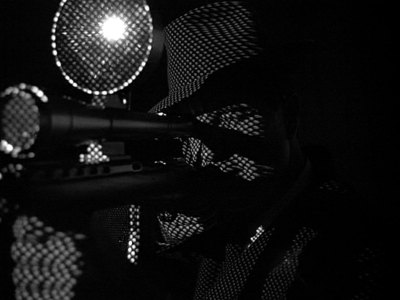
Here are the 16, one hour episodes of the six-disc box set, The Man From U.N.C.L.E.: The Complete Season 4:
DISC ONE:
The Summit-Fve Affair (September 11, 1967)
The Test Tube Killer Affair (September 18, 1967)
The "J" for Judas Affair (September 25, 1967)
DISC TWO:
The Prince of Darkness Affair, Part I (October 2, 1967)
The Prince of Darkness Affair, Part II (October 9, 1967)
The Master's Touch Affair (October 16, 1967)
DISC THREE:
The Thrush Roulette Affair (October 23, 1967)
The Deadly Quest Affair (October 30, 1967)
The Fiery Angel Affair (November 6, 1967)
DISC FOUR:
The Survival School Affair (November 20, 1967)
The Gurniu Affair (November 27, 1967)
The Man From Thrush Affair (December 4, 1967)
DISC FIVE:
The Maze Affair (December 18, 1967)
The Deep Six Affair (December 25, 1967)
DISC SIX:
The Seven Wonders of the World Affair, Part I (January 8, 1968)
The Seven Wonders of the World Affair, Part II (January 15, 1968)
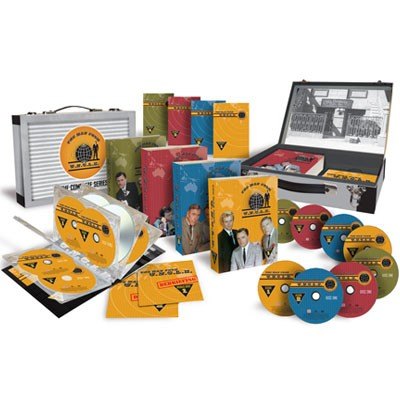
The DVD:
The Packaging:
I've included a picture of The Man From U.N.C.L.E.: The Complete Series' packaging (taken from Time-Life's website), which should give you a good idea how the series is arranged. Unfortunately, the packaging of this mammoth boxed set is a real drawback. First, the flimsy "U.N.C.L.E." briefcase that houses the discs is made of the cheapest cardboard imaginable - mine arrived totally ripped off its hinges, and split on the sides. They didn't even print the "U.N.C.L.E." artwork correctly - it's upside down on my case. To display it properly, I would have to set the briefcase upside down, on its handle - which of course won't work. That's a simple, yet incredibly stupid, mistake (and one that might really tick off collectors out there who paid a bundle for this set). As for the slimcase "booklets" that house the discs, since I've had this set, at least half of the center plastic tabs that actually hold the discs in place have broken off, so that now the discs are slipping and sliding (and scratching themselves) inside the "booklets." Seriously, for such a high priced item, this shoddy workmanship is an embarrassment. If you buy this set - and I most strenuously recommend that you do - get some clear holders and put the briefcase away.
The Video:
The full screen, 1.33:1 video image for The Man From U.N.C.L.E.: The Complete Series was, overall, quite good. The first season black & white episodes are clearly the best looking transfers here, with the later color episodes ranging from excellent to sometimes spotty. Fading colors, scratches, dirt, and a soft picture sometimes do crop up, but the vast majority of these episodes, while not pristine, look far better than you've ever seen them on cable or VHS. And as far as I can tell, all episodes seem to be full length and uncut (although the audio of June Foray's entreaty to stayed tuned to U.N.C.L.E. after station identification, is missing from the brief U.N.C.L.E. logo shot that silently follows each title sequence).
The Audio:
The English mono track for The Man From U.N.C.L.E.: The Complete Series accurately reflects the original broadcast presentation. Too bad composer Jerry Goldsmith's super-cool theme song (can you hear traces of the upcoming Flint films' themes here?) can't be heard in 5.1, but purist will no doubt like the big, fat mono sound.
The Extras:
Here's where The Man From U.N.C.L.E.: The Complete Series megaset really comes into its own, following the example of Time-Life's other stellar DVD release of Get Smart!: The Complete Series. Extras included are detailed, beautifully executed, and copious. To start, each individual season box set comes with an 8-page illustrated guide, which includes an introduction by Vaughn and McCallum (it's repeated for each guide), a complete episode guide, and then a nicely detailed run down of that particular season. Each season run down is written by a different author. Season one's run down is written by Craig Henderson, publisher of the first U.N.C.L.E. fanzine, and editor of For-Your-Eyes-Only.com. Season two's run down is written by Cynthia W. Walker, an assistant professor in the Department of Communication at St. Peter's College in Jersey City, NJ, who has written several pieces on the series. Season three's run down is written by David Bianculli, TV critics for the New York Daily News and author of Teleliteracy: Taking Television Seriously. And season four's run down is written by Jon Burlingame, a writer for Daily Variety and The New York Times. All of the guides offer juicy little tidbits on the production of the various seasons, while prepping the viewer for the coming episodes.
And within each box set, there are bonus discs with new and vintage extras that further the discussion of this entertaining series. In season one's disc set, we have the featurette, The Cloak & Swagger Affair, hosted by Robert Vaughn and David McCallum, which looks at the inception, production and reception of the cult TV series. Interviewees include Dean Hargrove (writer), Joseph Sargent (director), Norman Felton (executive producer), Richard Donner (director), George Lehr (associate producer), Fred Koenekamp (cinematographer), and Peter Allan Fields (writer). It runs 28:05, and it's a highly informative, energetic documentary, with all the principles in good form. Also included is the rare, color pilot episode, Solo, which M-G-M used to sell the series to NBC. It's great fun to watch and compare this and its subsequent black & white reworking, The Vulcan Affair. Solo runs 1:10:03. And finally, U.N.C.L.E.'s V.I.P.S. looks at the numerous guest stars from season one, with Vaughn, McCallum and other production members popping in to comment on an occasional guest. The caliber of guest stars for The Man From U.N.C.L.E. was high, as you can see from the list: Leigh Chapman, Pat Harrington, Jr., Janine Gray, Glenn Corbett, Gavin MacLeod, Werner Klmeperer, Patricia Crowley, William Marshall, Sue Ane Langdon, Madlyn Rhue, Herbert Anderson, Albert Paulsen, Dan O'Herlihy, Ken Murray, Zohra Lampert, Lloyd Bochner, Jill Ireland, Paul Lambert, Robert Culp, Lee Meriwether, Yvonne Craig, Leonard Nimoy, Cesar Romero, June Lockhart, William Shatner, James Doohan, Kurt Russell, George Sanders, Anne Francis, Barbara Feldon, Carroll O'Connor, Elsa Lanchester, Ricardo Montalban, Slim Pickens, Jill Ireland, Sharon Tate, Bonnie Franklin, Eddie Albert, Richard Kiel, and Richard Anderson. This bonus feature runs 9:47.
In season two's disc set, there's a terrific look at The Spy-Fi Tour: Archives, Art and Artifacts, a wonderful exhibit of original U.N.C.L.E. memorabilia, owned and curated by Danny Biederman, aboard the Queen Mary Hotel in Long Beach, California. It runs 23:26, and should drive every guy who loves this series absolutely insane with envy. As well, One Spy Too Many, the 1966 theatrical release of the expanded Alexander the Great Affair, Parts I and II, is included here. Numerous theatrical versions of expanded U.N.C.L.E. episodes were released during the series' run, to quite healthy box office, with additional sequences filmed to pad out the features' running times. Unfortunately, the video transfer for One Spy Too Many is quite poor here, with a second or third generation look - and plenty of video noise to spoil the picture. And finally, we have another U.N.C.L.E.'s V.I.P.S. tour of the guest stars that appear this season, including: Vincent Price, Dorothy Provine, Ricardo Montalban, Angela Lansbury, Mary Ann Mobley, Leigh Chapman, James Doohan, Martin Landau, Victor Buono, Jill Ireland, Norman Fell, Rip Torn, Maurice Evans, Eve Arden, Vera Miles, James Frawley, Leon Askin, Howard DaSilva, Jay North, Bruce Gordon, Vic Tayback, Claude Akins , Judi West, Harvey Lembeck, and the luscious Diane McBain. It runs 6:12.
In season three's disc set, the entire David McCallum/Robert Vaughn reunion interview, recorded in 2007, is included here (clips of which show up throughout the other bonus features). They're still pretty funny together, with Vaughn totally accepting U.N.C.L.E.'s impact on his career, while McCallum, in true Kuryakin form, still a tad standoffish about all the fuss. Lots of good info on the production of the series, as well as some fun trivia. The interview runs 1:17:40. Equally cool is a collection of home movies that McCallum shot behind-the-scenes of the various U.N.C.L.E. shoots, which may be the only visual record of that production. McCallum narrates, and it runs 16:58. And again, we have the U.N.C.L.E.'s V.I.P.S. tour of the guest stars that appear this season, including: Sonny Bono, Jack Palance, Janet Leigh, Eduardo Ciannelli, Jack La Rue, Joan Blondell, Joan Crawford, Cher, Nancy Sinatra, Joan Collins, Bill Dana, Jill Ireland, Terry-Thomas, Herbert Lom, Herbert Anderson, Jeannine Riley, Anne Jeffreys, Akim Tamiroff, Sharon Farrell, Theodore Marcuse, Ted Cassidy, Telly Savalas, Sharri Lewis, and Kim Darby.
And for season four's disc set, there's a fascinating look at the M-G-M backlot production of U.N.C.L.E., entitled MGM's Secret Operations, which runs a healthy 28:03. Lots of cool info here for the behind-the-scenes fanatics. And like the other sets, there's a U.N.C.L.E.'s V.I.P.S. tour of the guest stars that appear this season, including: Lola Albright, Jack Lord, Broderick Crawford, Chad Everett, Eleanor Parker, John Carradine, Julie London, Michael Rennie, Madlyn Rhue, Will Kuluva, Judy Carne, Barry Sullivan, Leslie Nielsen, Darren McGavin, Marlyn Mason, Barbara Moore, and the knee-weakening Carol Lynley.
If that weren't enough extras, The Man From U.N.C.L.E.: The Complete Series has two more discs included, in separate cardboard sleeves, with over four hours of additional features. On Bonus Disc one, several featurettes are included that further expand this set's almost encyclopedic reach of all things U.N.C.L.E.. Cold War, Hot Spies: U.N.C.L.E. and the Cold War looks, rather fancifully, at the political ramifications of the series. All of the principles of the previous featurettes are here, including Vaughn and McCallum. While one commentator says the show helped America see the Russians in a more humanized light (um...I don't think so), director Richard Donner puts it best when discussing television and movies: "Some people take it all just a little too seriously." Exactly. It runs 21:33. Gunms, Gadgets, Gizmos & Garb looks at all the cool weapons and toys that came out of the series. It runs 19:00. Behind the Wheel: U.N.C.L.E.'s Piranha looks at one of the coolest spy cars to ever grace the big or small screen - and some guy actually owns it! It's in mint condition. The detailed look at the Piranha runs 17:08. Fandemonium runs 25:08 and looks at the impact the series had on fans all over the world, as well as the merchandising boom that coincided with the series' popularity. The Music From U.N.C.L.E., running 23:32, tells you everything you could possibly want to know about the scintillating music - as well as the history and popularity of the various soundtrack albums - featured on U.N.C.L.E.. And finally, The Girls From U.N.C.L.E., probably my favorite extras included here, takes a jaw-dropping look at the absolutely gorgeous girls that strolled through the U.N.C.L.E. sets during the series' four seasons. Watch Vaughn crack up when McCallum makes a joke about Vaughn chasing the girls. Promos and trailers are also included. Promos for the television series include Summer, 1964, 1966-'67, Spring, 1967, "The Test Tube Killer Affair" (9/18/67), and Fall, 1967. Feature film trailers include To Trap a Spy, The Spy With My Face, One Spy Too Many, and One of Our Spies is Missing. And finally, in the Official Debriefings section, two interviews are included with Dean Hargrove (which runs 26:49), and David McCallum (which runs 21:12), where they discuss their involvement with the series.
On Bonus Disc two, more Official Debriefings interviews are included, featuring Richard Donner (28:25), George Lehr (1:10:03), Joseph Sargent (21:08) and Robert Vaughn (26:28). As you can see from those run times, these aren't quickie blow-off interviews. TV Appearances and Spots features some rare archival footage of the U.N.C.L.E. team outside their regular series. The Golden Globes Awards for 1965, aired live on The Andy Williams Show, 1/31/66, features Vaughn and McCallum accepting a Globe for Best TV Show. Vaughn holds McCallum's hand as they walk up to the podium, and Andy Williams cracks, "You guys have been together too long." The clip runs 1:12. The 1965 Emmy Broadcast, 9/12/65, features Vaughn and McCallum as presenters. There's a gag about walkie talkie Emmy's, and a bomb in Vaughn's waistcoat (it's nice to know that Emmy jokes stunk just as much back then as they do today). It runs 2:02. David McCallum on The Andy Williams Show, 9/20/65, runs 3:48, and features a funny little bit where McCallum discusses his various spy gadgets on his person. And there's a Tom and Jerry cartoon included, The Mouse from H.U.N.G.E.R., from 1967, directed by Abe Levitow, that spoofs U.N.C.L.E. (to get into his headquarters, Jerry has to give a hotfoot to a cigar store Indian). Unfortunately, it has gate registration problems, with its image pulsing back and forth over the screen And in the Photo and Image Galleries, there are a wealth of behind-the-scenes stills, blueprints, drawings, private photos, NBC memos, research files, sheet music, toys, publications, and some sweet movie posters for the U.N.C.L.E. feature films (of course, the Japanese posters steal the show).
I've never encountered a DVD boxed set with as many bonus extras - all of which are exceedingly polished and professionally produced, as well as detailed and informative - as The Man From U.N.C.L.E.: The Complete Series. Truly amazing.
Final Thoughts:
The Man From U.N.C.L.E.: The Complete Series was a complete revelation to me. Familiar with the show, but having never really seen it, I was knocked out by its strange, fanciful combination of witty, intelligent repartee and its paranoid fantasies of world domination facilitated by a sinister underground criminal organization. The United Network Command for Law and Enforcement, hidden away behind an innocuous tailor shop in New York City, perfectly embodied the sleek, modernized approach to crime fighting and espionage that was being popularized in the Bond films. Robert Vaughn's Napoleon Solo was the last gasp of the debonair, cultured American, while David McCallum's introspective, enigmatic, deadly Russian agent Illya Kuryakin, represented "the other" that increasingly appealed to Americans turning away from traditional hero models. The first season is the best, achieving a light Hitchcockian touch that you won't find anywhere in 1960s American television. Later seasons went for color and camp and comedy, but they have their own outsized charm, as well. This innovative, unique series is served well by one of the best boxed DVD collections I've ever encountered. Crammed with an insane amount of extras, while sporting complete, uncut, reasonably clean and sharp transfers, The Man From U.N.C.L.E.: The Complete Series is an exhaustive trip through this delightful Cold War romp, providing you with a Master's course in all things U.N.C.L.E.. It's just too bad the actual packaging was so dismal. Still, content is king here, and this stunning collection receives DVDTalk's highest rating: the DVD Talk Collector Series.
(Author's Note) I wish to thank the United Network Command for Law and Enforcement without whose assistance this review would not be possible.
Paul Mavis is an internationally published film and television historian, a member of the Online Film Critics Society, and the author of The Espionage Filmography.


|
| Popular Reviews |
| Sponsored Links |
|
|
| Sponsored Links |
|
|
| Release List | Reviews | Shop | Newsletter | Forum | DVD Giveaways | Blu-Ray | Advertise |
|
Copyright 2024 DVDTalk.com All Rights Reserved. Legal Info, Privacy Policy, Terms of Use,
Manage Preferences,
Your Privacy Choices | |||||||












